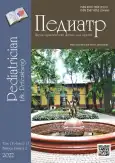Clinical case of neuronal ceroid lipofuscinosis type II in a child
- 作者: Belykh N.A.1, Starodubtseva Y.B.2, Sologub M.A.1, Pisnyur I.V.1
-
隶属关系:
- I.P. Pavlov Ryazan State Medical University
- Kolomna Central District Hospital
- 期: 卷 13, 编号 2 (2022)
- 页面: 89-97
- 栏目: Clinical observation
- URL: https://journals.rcsi.science/pediatr/article/view/109261
- DOI: https://doi.org/10.17816/PED13289-97
- ID: 109261
如何引用文章
详细
Neuronal ceroid lipofuscinosis is a group of hereditary neurodegenerative diseases inherited by an autosomal recessive trait. This disease is the most common neurodegenerative pathology in children with a prevalence of 1:1,000,000 to 1:14,000 in the world. Currently, 14 genetically different forms of this pathology have been identified, which are characterized by the accumulation of abnormal lipofuscin-like material in the lysosomes of nerve cells, progressive and selective destruction of neurons. In neuronal ceroid lipofuscinosis, there is a defect in the gene that translates various lysosomal enzymes. Due to the insufficiency of the enzyme tripeptidyl peptidase 1, an accumulation of pathological autofluorescent lipopigment is observed in the central nervous system (CNS) of the patient, leading to violations of the normal function of neurons. Clinically, the disease manifests at the age of 3–4 years, in the form of progressive myoclonic epilepsy, mental and motor disorders, delays and stops in development. The article describes data on the prevalence, clinical features and therapy of this pathology, and also presents a clinical case with the onset of the disease in a child aged 2 years 11 months. The clinical case demonstrates the difficulties of diagnosing this pathology due to the rarity of this pathology, a wide range of differential diagnostics, the duration and high cost of molecular genetic studies. An early diagnosing would make it possible to explain the nature of epilepsy, to choose a rational therapy for this disease in a timely manner.
作者简介
Natalia Belykh
I.P. Pavlov Ryazan State Medical University
Email: nbelyh68@mail.ru
MD, PhD, Dr. Med. Sci., Associate Professor, Head of the Department of faculty and polyclinic Pediatrics with the course of Pediatrics of the FDPO
俄罗斯联邦, RyazanYulia Starodubtseva
Kolomna Central District Hospital
Email: dokstarodub@gmail.com
Pediatrician, Head of the Pediatric Department No. 4
俄罗斯联邦, Moscow RegionMikhail Sologub
I.P. Pavlov Ryazan State Medical University
Email: mihailsologub99@gmail.com
Student V courses
俄罗斯联邦, RyazanInna Pisnyur
I.P. Pavlov Ryazan State Medical University
编辑信件的主要联系方式.
Email: innaabramova@yandex.ru
Assistant Professor of the Department of Faculty and Polyclinic Pediatrics with the Course of Pediatrics of the FDPO
俄罗斯联邦, Ryazan参考
- Zakharov AS, Korotkova NV, Mzhavanadze ND, Nikiforov AA. Biochemical and pathophysiological aspects of dysferlin-associated muscular dystrophy. Science of the young (Eruditio Juvenium). 2021;(1):157–169. (In Russ.) doi: 10.23888/HMJ202191157-169
- Kraeva LS, Koroleva ES, Alifirova VM, Kuzmina AV. A clinical case of neuronal ceroid lipofuscinosis type 2. Bulletin of Siberian Medicine. 2019;18(4):244–248. (In Russ.) doi: 10.20538/1682-0363-2019-4-244-248
- Sychev VV, Sychev VN, Shatrova NV. Peculiarities of organization of bioelectric brain activity in subclinical stage of epilepsy. I.P. Pavlov Russian Medical Biological Herald. 2017;25(3):399–403. (In Russ.) doi: 10.23888/PAVLOVJ20173399-403
- Johnson TB, Cain JT, White KA, et al. Therapeutic landscape for Batten disease: current treatments and future prospects. Nat Rev Neurol. 2019;15:161–178. doi: 10.1038/s41582-019-0138-8
- Kozina AA, Okuneva EG, Baryshnikova NV, et al. Neuronal ceroid lipofuscinosis in the Russian population: Two novel mutations and the prevalence of heterozygous carriers. Mol Genet Genomic Med. 2020;8(7): e1228. doi: 10.1002/mgg3.1228
- Lourenço CM, Pessoa A, Mendes CC, et al. Revealing the clinical phenotype of atypical neuronal ceroid lipofuscinosis type 2 disease: Insights from the largest cohort in the world. Paediatr Child Health. 2021;57(4):519–525. doi: 10.1111/jpc.15250
- Masten MC, Mink JW, Augustine EF. Batten disease: an expert update on agents in preclinical and clinical trials. Expert Opin Investig Drugs. 2020;29(12): 1317–1322. doi: 10.1080/13543784.2020.1837110
- Mink JW, Augustine EF, Adams HR, et al. Classification and natural history of the neuronal ceroid lipofuscinoses. Child Neurol. 2013;28(9):1101–1105. doi: 10.1177/0883073813494268
- Morsy A, Carmona AV, Trippier PC. Patient-Derived Induced Pluripotent Stem Cell Models for Phenotypic Screening in the Neuronal Ceroid Lipofuscinoses. Molecules. 2021;26(20):6235. doi: 10.3390/molecules26206235
- Nita DA, Mole SE, Minassian BA. Neuronal ceroid lipofuscinoses. Epileptic Disord. 2016;18(S2):73–88. doi: 10.1684/epd.2016.0844
- Qureshi YH, Baez P, Reitz C. Endosomal Trafficking in Alzheimer’s Disease, Parkinson’s Disease, and Neuronal Ceroid Lipofuscinosis. Mol Cell Biol. 2020;40(19): e00262–20. doi: 10.1128/MCB.00262-20
- Rodrigues D, de Castro MJ, Crujeiras P, et al. The LINCE Project: A Pathway for Diagnosing NCL2 Disease. Front Pediatr. 2022;10:876688. doi: 10.3389/fped.2022.876688
- Schaefers J, van der Giessen LJ, Klees C, et al. Presymptomatic treatment of classic late-infantile neuronal ceroid lipofuscinosis with cerliponase alfa. Orphanet J Rare Dis. 2021;16:221. doi: 10.1186/s13023-021-01858-6
补充文件









